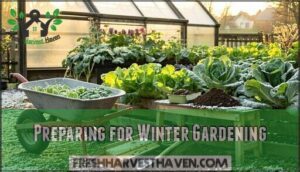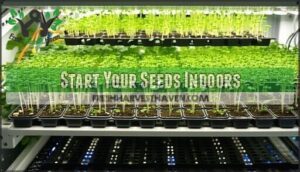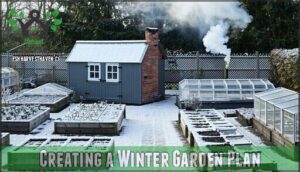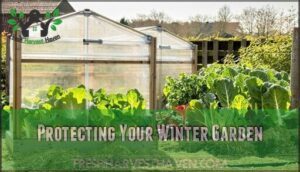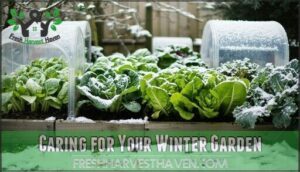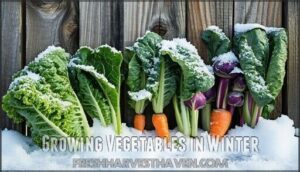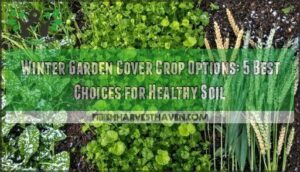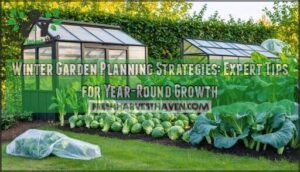This site is supported by our readers. We may earn a commission, at no cost to you, if you purchase through links.
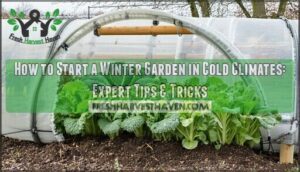 You’ll start a winter garden in cold climates by timing your plantings correctly – begin seeds in late summer so cold-hardy crops mature before deep winter arrives.
You’ll start a winter garden in cold climates by timing your plantings correctly – begin seeds in late summer so cold-hardy crops mature before deep winter arrives.
Choose vegetables like kale, spinach, carrots, and Brussels sprouts that actually improve in flavor after frost exposure.
Use season extension methods like cold frames, row covers, or low tunnels to protect plants and create favorable microclimates.
Focus on succession planting every 2-3 weeks for continuous harvests. Don’t forget to mulch heavily and select varieties specifically bred for cold tolerance.
The secret lies in understanding that winter gardening isn’t about fighting the cold – it’s about working with it strategically to maintain fresh harvests year-round.
Table Of Contents
- Key Takeaways
- Preparing for Winter Gardening
- Starting a Winter Garden in Cold Climates
- Selecting The Right Plants for Winter
- Creating a Winter Garden Plan
- Protecting Your Winter Garden
- Caring for Your Winter Garden
- Growing Vegetables in Winter
- Extending The Winter Gardening Season
- Winter Garden Maintenance and Upkeep
- Bringing Your Winter Garden Indoors
- Frequently Asked Questions (FAQs)
- How do you start a garden in the winter?
- Is gardening in winter a good idea?
- How do I choose a plant for winter gardening in Zone 1?
- How do I choose a plant for winter?
- What are the best winter gardening strategies in Zone 1?
- Which plants can be grown during winter?
- What month do you start a winter garden?
- How cold is too cold for gardening?
- What is a cold frame for winter gardening?
- How to grow vegetables in cold weather?
- Conclusion
Key Takeaways
- Time your plantings correctly – Start seeds in late summer (August-September) so that cold-hardy crops mature before deep winter hits your area.
- Choose frost-loving vegetables – Plant kale, spinach, carrots, and Brussels sprouts that actually taste sweeter after frost exposure and can handle freezing temperatures.
- Use season extension methods – Install cold frames, row covers, or hoop tunnels to create protective microclimates that add 5-10°F of warmth around your plants.
- Focus on succession planting – Stagger new plantings every 2-3 weeks for continuous harvests throughout winter, and mulch heavily to insulate the soil from temperature swings.
Preparing for Winter Gardening
Starting a winter garden in cold climates requires careful planning that begins months before the first frost hits.
You’ll need to understand your hardiness zone, calculate frost dates, and select appropriate season extension methods.
To create a thriving garden that produces fresh food throughout the coldest months, these steps are crucial, involving a thorough approach to season extension methods.
Know Your Hardiness Zone
Before winter’s bite sets in, you’ll need to master your hardiness zone—the geographic blueprint that determines which plants can survive your area’s coldest temperatures.
The USDA Plant Hardiness Zone Map divides regions into zones 1-13, with cold climates (zones 1-5) requiring strategic plant selection based on zone minimums.
You can find your exact zone by entering your ZIP code on the USDA website, but don’t stop there.
Microclimate effects create pockets where temperatures vary from the broader zone—a south-facing wall might boost sunlight exposure by 30%, while wind protection can reduce heat loss by 50%.
These variations directly impact your frost dates and winter garden planning success.
Understanding these temperature patterns isn’t just gardening theory; it’s your foundation for cold climate gardening victories that’ll have neighbors wondering how you pulled off winter magic.
Check Your First and Last Frost Dates
Understanding frost date impact transforms your cold climate gardening from guesswork into strategic planning.
These dates define your growing season boundaries and determine when tender plants face danger.
Historical frost data from your local extension office provides the most reliable foundation, but don’t forget microclimate variations within your property.
That south-facing wall might create a pocket 10°F warmer than your main garden.
Smart gardeners follow these frost timing essentials:
- Buffer zone importance: Add two weeks to last frost dates before planting tender crops
- Zone hardiness limits: Cross-reference frost dates with your hardiness zone for plant selection
- Microclimate mapping: Use thermometers to identify frost-prone and protected areas
Your frost dates aren’t just calendar markers—they’re your winter garden’s survival guide.
Knowing your area’s average last frost helps determine when it’s safe to plant.
Choose The Right Season Extension Method
Once you’ve pinpointed your frost dates, selecting the right season extension methods becomes your ticket to year-round harvests. Cold climate gardening doesn’t have to end when temperatures drop.
Cold frames act like mini-greenhouses, capturing solar heat in simple wooden boxes with glass or plastic tops. They’re perfect for hardening off seedlings and protecting lettuce through winter.
Row covers offer lightweight protection, adding 2-8°F of warmth while letting sunlight through. Think of them as cozy blankets for your plants.
Hoop tunnels create walk-in growing spaces using PVC hoops and plastic sheeting. They’re ideal for protecting larger beds of winter vegetables.
Greenhouses provide ultimate control with proper ventilation and heating options for serious cold climate gardening.
Here’s what works best for different situations:
- Small spaces: Cold frames and row covers maximize protection without taking up much room
- Larger gardens: Hoop tunnels cover multiple rows efficiently
- Year-round growing: Greenhouses enable true season extension methods
- Budget-conscious: Winter sowing in milk jugs costs almost nothing
Position structures against south-facing walls for maximum heat capture and wind protection. Many gardeners find pre-made options useful for convenience.
Starting a Winter Garden in Cold Climates
Starting a winter garden in cold climates requires careful timing and strategic planning to guarantee your plants survive freezing temperatures.
Success depends on understanding your local frost dates and choosing the right combination of cold-hardy varieties with proper protection methods.
Timing is Everything
Since perfect timing separates thriving winter gardens from frozen failures, you’ll need to master the art of optimal planting schedules. Your success depends on understanding frost dates and your hardiness zone to create precise harvest windows.
Frost prediction becomes your secret weapon—track both first and last frost dates in your region to establish clear sowing windows. Most cold climate gardening experts recommend starting hardy vegetables 4-6 weeks before severe frost hits, giving plants time to establish strong root systems.
Succession planting transforms your winter garden into a continuous harvest machine. Stagger your crops based on maturity times, planting new rows every 2-3 weeks. This guarantees you’re not overwhelmed with produce all at once while maintaining fresh harvests throughout the season.
Seed starting timing varies by crop—leafy greens need 30-45 days, while root vegetables require 60-90 days. Mark your calendar, check weather forecasts, and remember that perfect timing means respecting nature’s rhythms rather than fighting them.
Start Your Seeds Indoors
Getting the timing right sets you up for success, but your plants need a strong start to handle winter’s challenges. Indoor seed starting gives your seedlings the head start they need to thrive in cold conditions.
Create the perfect growing environment with these key elements:
- Heat mats maintain the right soil temperature (65-70°F) for faster seed germination
- Grow lights provide 14-16 hours daily of consistent illumination for healthy growth
- Quality potting mixes with peat and perlite guarantee proper drainage and root development
- Bottom watering prevents damping-off disease while keeping soil consistently moist
- Proper indoor timing starts seeds 6-8 weeks before your last frost date
Choose cold-hardy varieties that handle temperature drops well. Monitor your seedlings daily and begin seedling hardening 7-10 days before transplanting outdoors. This gradual acclimation process strengthens stems and prepares plants for outdoor conditions. Your indoor setup becomes a seedling factory, producing robust transplants ready for winter’s test.
Prepare Your Soil and Garden Beds
With your seedlings thriving indoors, it’s time to prepare their outdoor home. Start with soil testing to verify your pH sits between 6.0-7.0 for ideal winter crop performance. Next, work 2-3 inches of aged compost into your beds—this compost incorporation boosts organic matter that keeps working even when temperatures drop. To perform this vital step, consider using a reliable testing kit.
Consider these bed preparation advantages:
- Raised beds warm faster and drain better than ground-level plots
- They prevent waterlogged roots during winter thaws
- You’ll harvest more comfortably on snowy days
Apply mulch application of 4-6 inches using straw or shredded leaves after your first light frost. This winter blanket stabilizes soil temperature and suppresses weeds. For unused sections, plant cover crops like winter rye to prevent erosion while naturally enriching your soil for spring.
Transplant Your Seedlings
Now you’re ready to move those young plants outdoors.
Start the acclimation process by hardening techniques over 7-10 days, gradually exposing seedlings to wind and temperature changes.
When transplant timing feels right, work during mid-morning warmth.
Handle seedling care gently to avoid root disturbance, maintaining soil around roots.
Space plants according to mature size needs, then water at soil level and mulch for protection.
Selecting The Right Plants for Winter
Smart plant selection separates successful winter gardeners from those who struggle through the cold months.
Your hardiness zone determines which cold-hardy varieties will thrive in your specific climate conditions.
- Root vegetables like carrots and parsnips develop incredible sweetness after frost exposure
- Leafy greens including kale and spinach maintain hardiness down to 20°F with minimal protection
- Brassicas such as Brussels sprouts excel in cold conditions throughout winter
- Hardy herbs like thyme provide fresh flavors during the coldest months
Creating a Winter Garden Plan
A successful winter garden starts with thoughtful planning that considers both beauty and function throughout the coldest months.
You’ll need to think about structural elements, plant placement, and protective features that work together to create a garden that thrives despite freezing temperatures, which is a key aspect of a garden’s function.
Consider Structure and Form
Beyond selecting cold-hardy plants, your winter garden needs strong bones to weather the season’s challenges. Winter garden structure becomes your landscape’s foundation when snow covers everything else.
Evergreen backdrops provide year-round stability, while garden art creates focal points that catch the eye. Defined borders establish your winter garden boundaries, and varied plant forms add dramatic silhouettes against snowy backdrops.
Think of structure as your garden’s skeleton – it supports everything else. Mix heights, textures, and winter interest elements for sunlight optimization and visual appeal.
| Structure Element | Winter Function |
|---|---|
| Evergreen shrubs | Windbreaks and color |
| Ornamental grasses | Movement and texture |
| Garden sculptures | Focal points in snow |
| Stone paths | Navigation and definition |
Your winter garden design should create winter garden location planning that maximizes both beauty and function throughout the cold months.
Emphasize Plant Placement
Once you’ve established your garden’s structural foundation, plant placement becomes your winter garden’s game-changer. Position cold-hardy plants near south-facing walls where thermal mass creates microclimates up to 10°F warmer than surrounding areas.
Sunlight maximization and windbreak strategies transform challenging cold climate gardening into successful harvests. Use taller plants as windbreaks to shield delicate varieties from harsh winds. Group companions with similar hardiness zone requirements for microclimate creation. Maximize sunlight optimization by placing shorter plants in front of taller ones, which can be achieved through:
- Use taller plants as windbreaks to shield delicate varieties from harsh winds
- Group companions with similar hardiness zone requirements for microclimate creation
- Maximize sunlight optimization by placing shorter plants in front of taller ones
Container mobility lets you relocate plants to protected spots during extreme weather, making your winter garden adaptable to changing conditions. Remember to prepare soil properly with compost for insulation.
Define Garden Spaces With Hedging
After positioning your plants strategically, hedging becomes your winter garden’s backbone for creating defined spaces and natural garden borders.
Evergreen shrubs like boxwood and arborvitae excel as hedge plants because they maintain structure year-round while blocking harsh winter winds.
These evergreen hedge types create protective microclimates for tender plants sheltered behind them.
Garden fencing made from living hedges beats artificial barriers every time.
Dense varieties like yew and holly thrive in freezing temperatures, making them perfect for winter landscaping.
You can mix heights—taller hedges along perimeters, shorter ones for internal space definition.
Formal hedges with crisp lines create elegant garden rooms, while informal plantings offer softer boundaries.
Deciduous options like privet reveal stunning branch architecture when leaves drop, adding winter interest.
Strategic hedging transforms your winter garden into organized, protected outdoor rooms.
Consider Garden Furnishings
Throughout your winter garden design, winter garden furnishings serve as both functional elements and aesthetic anchors that bring life to dormant landscapes.
Strategic placement of these features creates inviting outdoor spaces even during harsh weather.
- Garden benches and outdoor furniture provide comfortable viewing spots for appreciating winter beauty
- Bird baths and feeders attract wildlife, adding movement and sound to quiet winter scenes
- Garden art and winter decor create focal points when plants lack seasonal interest
- Outdoor lighting and pathway materials guarantee safe navigation while highlighting garden structures after dark
Protecting Your Winter Garden
Once you’ve planned your winter garden layout, protecting those tender plants becomes your top priority.
Winter’s harsh conditions can devastate unprotected crops, but smart frost protection strategies keep your garden thriving through cold snaps.
Cold frames act like mini-greenhouses, trapping solar heat during sunny days while shielding plants from freezing winds.
Row covers winter protection works similarly—lightweight fabric creates a warm microclimate while allowing light penetration.
Position these covers before temperatures drop below freezing for maximum effectiveness.
Mulching techniques provide essential soil insulation.
Apply 4-6 inches of straw or shredded leaves around plant bases after the ground begins freezing.
This organic blanket stabilizes soil temperatures and prevents damaging freeze-thaw cycles that can heave plants from the ground.
Windbreaks reduce heat loss dramatically.
Even a simple burlap screen or evergreen hedge cuts wind speed by 50%, protecting winter plants from desiccation and temperature stress.
Challenge Solution
Caring for Your Winter Garden
Once your winter garden is established, regular care keeps your plants thriving through the cold months.
You’ll need to adjust your watering schedule, monitor for cold-weather pests, and harvest crops at the right time for best flavor and nutrition.
What to Expect During The Cold Months
Your winter garden will face nature’s toughest tests, but understanding what’s coming helps you stay ahead of potential problems.
Cold climate gardening brings predictable challenges that can catch new gardeners off guard. Winter damage occurs when temperatures drop suddenly or fluctuate wildly, creating stress on even cold hardy vegetables. Frost protection becomes essential during these periods.
Here’s what you’ll encounter:
- Dormancy periods – Plants slow growth dramatically, conserving energy for survival
- Freeze-thaw cycles – Soil expands and contracts, potentially heaving plants from beds
- Inconsistent snow cover – Natural soil insulation that appears and disappears unpredictably
- Wildlife pressure – Hungry animals seeking food sources in your protected spaces
Cold snaps test your winter garden protection systems, while microclimate creation around structures moderates extreme temperature swings. Frost dates mark critical periods when extra vigilance prevents losses.
Watering and Feeding Your Plants
Despite winter’s harsh appearance, your plants still crave proper soil moisture and plant nutrition.
Check winter garden soil weekly, watering mid-morning when temperatures climb above freezing.
Snow acts as nature’s blanket, so don’t panic when it covers your beds.
Apply compost tea monthly for gentle feeding—your winter garden fertilizer shouldn’t be heavy-handed.
Remember: water conservation matters, but consistency prevents root damage from freeze-thaw cycles.
Monitoring for Pests and Diseases
During winter months, garden pest control becomes essential as certain winter pests adapt to cold conditions.
Watch for aphids in protected areas—they infest 30% of unheated greenhouses. Slugs hide under mulch, while rodents seek shelter in garden beds.
Pest management requires weekly visual inspections, which reduce outbreaks by 60%. Use sticky traps for early detection and floating row covers for garden pest protection.
Disease management focuses on downy mildew and gray mold in high humidity. Strong soil health supports natural pest control resistance.
Effective winter garden solutions are essential for maintaining a healthy winter garden.
Harvesting Your Winter Crops
After weeks of careful tending, reaping your winter harvest brings unmatched satisfaction. Crop timing matters most—harvest root vegetables just after frost exposure for maximum sweetness, as cold temperatures convert starches to sugars. Winter yields improve with proper harvest techniques and attention to soil temperature fluctuations.
Regular harvesting stimulates continued production in leafy greens, while frost protection guarantees quality crops survive harsh conditions:
- Feel the thrill of pulling sweet carrots from snow-covered beds
- Experience the satisfaction of crisp kale leaves defying winter’s grip
- Enjoy the pride of homegrown vegetables when grocery stores offer wilted options
Use insulated baskets during mid-morning collection when temperatures rise slightly. Cut leafy greens at soil level, leaving roots for potential regrowth. Master these harvest methods and crop storage techniques to extend your winter crops enjoyment for weeks.
Growing Vegetables in Winter
Winter vegetable gardening transforms your frozen landscape into a productive food source with the right planning and techniques.
You’ll discover that cold-hardy crops like kale, carrots, and Brussels sprouts actually taste sweeter after frost exposure while providing fresh nutrition throughout the coldest months.
Get Ready in Summer
Success in winter gardening depends on smart summer planning that sets the foundation for cold-weather harvests. Start by testing your soil pH in early summer – you’ll want it between 6.0 and 7.0 for maximum nutrient uptake.
Map your garden design and identify microclimates like south-facing walls that stay warmer. To further protect plants, consider using cold frames for added insulation.
| Summer Task | Timing | Purpose |
|---|---|---|
| Soil pH Testing | Early June | Allows time for amendments |
| Seed Selection | Mid-July | Ensures cold-hardy varieties |
| Tool Preparation | Late August | Sharp tools prevent plant damage |
Mid-summer marks prime time for browsing seed catalogs. Focus on varieties that thrive in your hardiness zone and can handle your area’s frost dates. Many experienced gardeners swear by ordering seeds in July to avoid sold-out favorites.
Don’t forget soil amendments – incorporate compost or aged manure before temperatures drop. This gives organic matter time to integrate properly, creating the rich foundation your winter crops will need.
1Start Your Seeds
Starting seeds indoors gives you complete control over your winter vegetable timeline. You’ll want to begin this process 8-12 weeks before your first frost date, depending on which crops you’re growing.
Fill seed trays with high-quality seed starting mix that drains well but retains moisture. Position trays under indoor lighting for 12-14 hours daily—grow lights work better than windowsills for consistent results. Heat mats boost seed germination rates by maintaining that sweet spot of 65-70°F that most winter vegetables crave.
Monitor soil temperature with a thermometer since cold soil kills germination faster than you can say "failed harvest." Water gently to keep soil evenly moist without creating swamps.
Succession planting every 2-3 weeks guarantees continuous harvests through winter’s lean months.
Here’s your action plan:
- Track planting dates on a calendar for perfect timing
- Feed seedlings diluted fertilizer once true leaves appear
- Begin seedling hardening two weeks before transplanting outdoors
This methodical approach transforms tiny seeds into robust plants ready for winter’s challenges.
3Prepare Your Covers
After starting your seeds, it’s time to set up proper frost protection.
Row covers made from spun fabric provide immediate insulation, while cold frames offer sturdy shelter down to 24°F.
Hoop tunnels and mini greenhouses create warm microclimates, boosting temperatures by 5-10°F.
When installing these structures, make certain they’re anchored securely and include ventilation panels—even winter crops need airflow on sunny days to prevent overheating.
4Plant Your Crops
With your protective covers in place, it’s time to plant your cold-hardy crops for winter harvest. Focus on variety selection that matches your hardiness zone and frost dates.
Here’s your planting strategy for winter hardy vegetables:
- Space wisely: Plant coldhardy crops with proper planting density to guarantee good air circulation and prevent disease buildup
- Practice succession sowing: Stagger plantings every 2-3 weeks for continuous harvests throughout winter
- Use companion planting: Pair brassicas with alliums, or root vegetables with leafy greens for mutual protection
- Implement crop rotation: Avoid planting the same family in identical spots to maintain soil health
Plant slightly deeper than summer crops to provide extra root insulation against freezing temperatures.
Extending The Winter Gardening Season
You can extend your winter gardening season well beyond what nature typically allows with the right protection methods and strategic planning.
These techniques help you harvest fresh vegetables months longer and get a head start on spring planting.
Using Row Covers and Freeze Protection
You’ll need effective frost protection methods to keep your winter vegetables thriving when temperatures drop.
Row covers come in several types: lightweight frost blankets protecting down to 28°F and heavier materials for severe cold. Frost blanket weight matters—choose 0.5-ounce fabric for light protection or 1.5-ounce for emergency freeze protection.
Selecting the right product can substantially impact effectiveness, so consider various blanket options.
Securing row covers properly prevents wind damage and heat loss. Anchor edges with sandbags, clips, or bury them in soil trenches.
Remember your plant hardiness limits—even covered plants have temperature thresholds. Check row covers during sunny days and provide ventilation to prevent overheating.
These simple protection methods extend your harvest weeks beyond normal frost dates in cold climates.
Creating a Microclimate With Greenhouses
Greenhouses create warm pockets that extend your growing season by 4-8 weeks in cold climates.
Greenhouse Materials like double-walled polycarbonate panels boost interior temperatures by 15°C compared to outside air.
Greenhouse Size and Greenhouse Placement matter—position yours facing south for maximum winter sunlight.
Temperature Control requires thermal mass like water barrels to stabilize nighttime temperatures.
Greenhouse Ventilation prevents humidity buildup that causes mold.
These microclimates transform season extension methods into year-round greenhouse gardening success.
Preparing for Spring Gardening
Winter’s tail end offers the perfect opportunity to prep for spring’s arrival. Start by testing your soil temperature and health—think of it as your garden’s annual physical exam.
Apply soil amendments like compost to boost nutrients and structure for the upcoming growing season. Begin seed starting indoors while outdoor conditions remain too harsh for direct planting.
Sharp, clean tools make garden work easier, so tackle tool maintenance now before spring’s busy rush arrives. Plan your garden layout and crop rotation to maximize productivity and minimize pest problems.
Early planting preparation during winter garden planning for spring guarantees your soil warming process starts smoothly. Spring season preparation includes organizing seed packets, checking germination dates, and mapping out planting schedules based on your last frost date.
- **Garden planning for spring success starts with soil testing, seed inventory, and plotting your planting timeline for superior results.
Overwintering Plants for an Early Start
Getting ahead of spring starts with smart plant overwintering in cold climates. Hardy varieties benefit from proper dormancy strategies and cold stratification during winter months.
Strategic overwintering extends your growing season substantially while protecting valuable plants from harsh conditions.
Tips:
- Apply mulch techniques around root zones before ground freezes
- Use container protection for tender perennials you want to save
- Choose frost protection methods like burlap wraps for borderline plants
- Plan early harvests by selecting varieties that tolerate temperature swings
- Root cellaring works perfectly for storing dormant bulbs, tubers, and bare-root plants at 32-40°F with high humidity
Winter Garden Maintenance and Upkeep
Once your winter garden is established, you’ll need to maintain it properly throughout the cold months to guarantee healthy plants and productive harvests.
Regular maintenance tasks like pruning, container management, and composting will keep your garden thriving even when temperatures drop.
Prune for Plant Health
Cold weather offers perfect conditions for dormant pruning in your winter garden. Your plants are sleeping, making this the safest time to grab sharp, clean tools and get to work.
Target dead, diseased, or crossing branches first—these steal energy from healthy growth. Disease prevention starts with removing problem areas before they spread. Make clean cuts just outside branch collars to avoid wound vulnerability that could invite infections.
Pruning timing matters in cold climates. Late winter works best when plants are fully dormant but before buds swell. This winter garden pruning technique reduces stress and promotes vigorous spring growth.
Shaping plants becomes easier when you can see their true structure without leaves. Focus on opening up crowded centers for better airflow—your plants will thank you with stronger, healthier growth come spring.
Rely on Containers
Why limit yourself to ground-level gardening when containers offer unmatched flexibility for winter container gardening? Container mobility lets you chase sunlight and dodge harsh weather, while proper root insulation keeps cold-hardy plants thriving through frigid months.
Choose durable materials like plastic or fiberglass that won’t crack in freezing temperatures.
Essential winter container strategies include:
- Large containers (12+ inches diameter) provide better root insulation than smaller pots
- Grouping containers creates protective microclimates that raise surrounding temperatures
- Mulching soil surface with 3-4 inches of organic material shields roots from frost
- Elevating on pot feet prevents direct ground contact and improves drainage
- Wrapping with burlap adds extra insulation during extreme cold snaps.
Address watering challenges by checking soil moisture regularly—overwatering causes root rot while underwatering leads to desiccation.
Select frost-resistant plants rated two zones colder than your area, and use well-draining potting mix to prevent waterlogging.
This approach transforms your winter garden into a moveable feast of cold-weather beauty.
Feature Topiaries and Plant Forms
Transform your winter garden into a living sculpture gallery with strategic topiary designs and creative winter shapes.
Topiary techniques using evergreen shrubs create stunning structural interest that thrives in cold climates.
Position boxwood spirals or yew cones as focal points throughout your winter landscaping.
These artistic expression elements require minimal form maintenance while delivering maximum visual impact.
Your winter garden planning should include these architectural plants as permanent features that shine when other vegetation disappears.
Keep Composting
Winter composting transforms kitchen scraps into soil amendment gold, even when temperatures plummet below freezing.
Winter composting works beautifully with proper compost insulation and balanced compost materials.
- Layer coffee grounds and vegetable peels for nitrogen-rich green materials
- Add dried leaves, straw, or shredded paper for carbon balance
- Insulate your pile with extra straw or organic materials for heat retention
- Turn the pile monthly to maintain proper compost pH and decomposition
This steady process guarantees rich soil amendments ready for spring planting in your winter garden. You can also improve soil health by applying compost before the ground freezes.
Bringing Your Winter Garden Indoors
When temperatures drop and outdoor conditions become harsh, you can continue your winter gardening passion by moving select plants and activities indoors.
This shift allows you to maintain fresh herbs, start seeds for next season’s slow-growing vegetables, and enjoy the beauty of winter-interest plants while staying warm and cozy inside your home.
Grow Herbs Indoors in Pots
Keep your indoor winter garden thriving with these herb-growing basics. Most herbs adapt well to indoor conditions, but success depends on getting the fundamentals right.
- Herb selection matters: Choose hardy varieties like rosemary, thyme, sage, and oregano that tolerate indoor conditions better than delicate herbs
- Indoor lighting requirements: Provide 6-8 hours of bright light daily using south-facing windows or LED grow lights for ideal growth
- Potting mix selection: Use well-draining, lightweight potting mix with good aeration to prevent waterlogged roots that kill herbs quickly
- Watering herbs properly: Water when top inch of soil feels dry, allowing excess water to drain completely through pot holes
- Pest control vigilance: Check regularly for aphids and spider mites, treating naturally with insecticidal soap when needed
Regular harvesting encourages bushy growth while providing fresh flavors for your winter cooking.
Start Seeds Indoors for Slow-Growing Vegetables
While growing herbs indoors keeps your kitchen stocked, indoor seed starting for slow-growing vegetables requires different planning.
Heat mats maintain proper seed germination temperatures around 70°F, while grow lights provide consistent indoor lighting for 12-14 hours daily. Quality potting mixes guarantee proper drainage and nutrients.
Start tomatoes, peppers, and eggplants 8-10 weeks before your last frost date. Winter sowing mimics natural germination conditions.
Practice seedling hardening by gradually exposing plants to outdoor conditions over 7-10 days. Perfect transplant timing means strong, stocky seedlings ready for cold climates.
Bring in Plants for Winter Interest
While indoor seedlings get established, bring outdoor plants inside to create winter interest throughout your home.
Your winter garden planning doesn’t stop at the greenhouse door.
Transform any room into a cold climate showcase with these winter interest plants:
- Evergreen Structure – Boxwood and holly maintain their rich green foliage, providing reliable color through the darkest months
- Winter Color – Cyclamen and kalanchoe offer vibrant blooms that last for weeks on sunny windowsills
- Textured Bark – Potted Japanese maples display stunning bark patterns that become focal points without leaves
- Berries/Seedheads – Winterberry branches and ornamental grass plumes add natural texture and movement indoors
These Fragrant Blooms and structural elements create living artwork that brightens winter garden vegetables and extends your growing season indoors.
Create a Winter Garden Journal
Document your winter garden journey with a detailed journal that tracks frost dates, weather patterns, and plant performance.
Your winter garden journal becomes a powerful tool for analyzing successes and documenting challenges across seasons.
| Category | What to Record | Why It Matters |
|---|---|---|
| Weather Data | Frost dates, temperatures, precipitation | Plan rotations and timing |
| Plant Performance | Growth rates, harvest yields, disease issues | Track progress year-over-year |
| Garden Layout | Bed arrangements, companion planting, spacing | Optimize future plantings |
| Seasonal Notes | Pest observations, soil conditions, cover crop results | Record observations for improvement |
This winter tracking system helps you spot patterns in your cold climate gardening.
Note which varieties thrived and which struggled, creating your personalized winter garden planning guide for future seasons.
Frequently Asked Questions (FAQs)
How do you start a garden in the winter?
Last winter, Sarah discovered she could grow fresh spinach in her backyard even during January’s snowstorms.
Start your winter garden by selecting cold-hardy vegetables like kale, carrots, and spinach, then protect them with row covers or cold frames for success.
Is gardening in winter a good idea?
Winter gardening is absolutely worth it! You’ll enjoy fresh vegetables, extend your growing season, and discover that many crops actually taste sweeter after frost hits them naturally.
How do I choose a plant for winter gardening in Zone 1?
Ironically, Zone 1’s brutal winters make plant selection surprisingly simple—you’re limited to extremely hardy varieties.
Choose plants rated for zones 1-3, like Siberian kale, winter rye, or arctic willows that survive -50°F temperatures.
How do I choose a plant for winter?
Choose plants based on your hardiness zone and frost tolerance.
Select cold-hardy varieties like kale, spinach, carrots, and Brussels sprouts that thrive in low temperatures and actually improve flavor after frost exposure.
What are the best winter gardening strategies in Zone 1?
In Zone 1’s brutal conditions, you’ll need maximum protection strategies.
Use heated greenhouses, deep cold frames, and heavy mulching systems.
Focus on ultra-hardy varieties like winter rye and employ succession planting indoors for continuous harvests.
Which plants can be grown during winter?
Don’t let Jack Frost intimidate you—you’ll thrive growing hardy vegetables like kale, spinach, carrots, and Brussels sprouts.
These cold-weather champions tolerate freezing temperatures and actually taste sweeter after frost hits your garden beds.
What month do you start a winter garden?
You’ll start your winter garden in late summer, typically August through early September in most cold climates.
This timing lets you plant cool-season crops that’ll mature before harsh winter weather arrives.
How cold is too cold for gardening?
Arctic-level temperatures become gardening’s nightmare – but you can still grow.
Hardy vegetables like kale and spinach thrive down to 20°F (-6°C) with protection, while root crops survive even colder with mulch coverage.
What is a cold frame for winter gardening?
A cold frame is a bottomless wooden or plastic box with a transparent lid that creates a protective microclimate for plants.
You’ll place it over garden beds to trap solar heat and shield crops from harsh winds and frost.
How to grow vegetables in cold weather?
Picture frost-kissed kale leaves glistening in morning light, defying winter’s grip.
Choose cold-hardy varieties like spinach, carrots, and Brussels sprouts.
Use row covers, cold frames, and mulch for protection. Plant succession crops for continuous harvests throughout winter.
Conclusion
Winter gardening transforms barren landscapes into productive havens when you master the fundamentals.
Success depends on understanding your climate zone, timing plantings correctly, and selecting cold-hardy varieties that thrive in harsh conditions.
You’ll discover that learning how to start a winter garden in cold climates requires patience and strategic planning, but the rewards are substantial.
With proper season extension techniques, soil preparation, and plant protection methods, you’ll harvest fresh vegetables throughout winter while building gardening skills that last a lifetime.
- https://www.gardenary.com/blog/winter-garden-survival-tips
- https://www.theprairiehomestead.com/2019/05/how-to-garden-in-a-cold-climate.html
- https://homesteadingfamily.com/gardening-in-winter-cold-weather-growing-methods/
- https://www.quora.com/How-do-I-grow-a-garden-in-the-winter
- https://www.finegardening.com/project-guides/fruits-and-vegetables/cold-frame-gardening?srsltid=AfmBOop0W5KSCMQRhmrEVy7ZOL1VxNo5-Ln2YJWyqk9ZGpJth8MjIkUh

